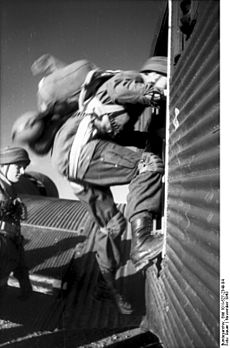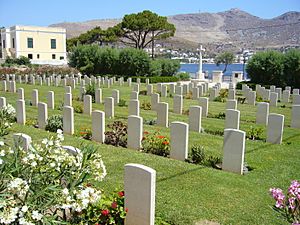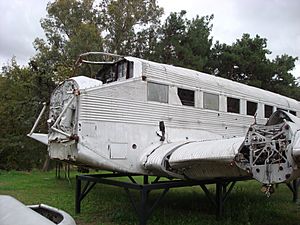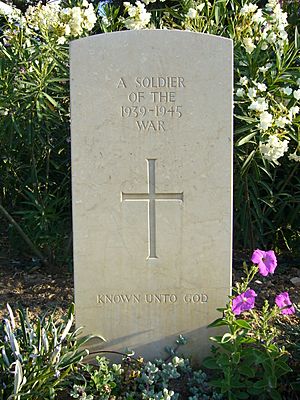Battle of Leros facts for kids
Quick facts for kids Battle of Leros |
|||||||
|---|---|---|---|---|---|---|---|
| Part of the Dodecanese campaign of World War II | |||||||
 German paratroopers prepare to be flown to Leros. |
|||||||
|
|||||||
| Belligerents | |||||||
Naval Support: |
|||||||
| Commanders and leaders | |||||||
| Strength | |||||||
| Italian: 8,320 soldiers and sailors British: 3,500+ soldiers 74 Squadron, RAF 7 Squadron, SAAF |
2,800 German soldiers extensive air power |
||||||
| Casualties and losses | |||||||
| Italian: 254 killed or missing 5,350 POWs 1 destroyer sunk 5 auxiliary and merchant ships sunk 5 Armored Motor Boats and Torpedo Boats sunk British: ~600 killed 100 wounded 3,200 POWs 115 RAF aircraft lost 3 destroyers sunk Greek: 1 destroyer sunk 68 |
512 killed, 900 wounded at least five MFPs |
||||||
| 20 civilians killed (Leros Islanders) | |||||||
The Battle of Leros was a major fight during World War II in 1943. It happened on the Greek island of Leros in the Aegean Sea. This battle was a big part of the Dodecanese campaign.
After Italy signed a peace agreement with the Allies in September 1943, the Italian soldiers on Leros were joined by British forces. But German forces wanted to take control of the island. The battle started with German air attacks on September 26 and ended on November 16, 1943, when the Allied forces surrendered.
Contents
Why Leros Was Important
The island of Leros is part of the Dodecanese islands. These islands are in the southeastern Aegean Sea. Italy had controlled them since the Italo-Turkish War.
Leros was very important because it had a great deep-water port called Lakki. Italy had turned it into a strong naval and air base. It was even called "the Corregidor of the Mediterranean" by Benito Mussolini, Italy's leader at the time.
After Greece fell to the Axis powers in 1941, and the Allies lost Crete, Greece and its islands were occupied by German and Italian forces. When Italy surrendered in September 1943, the Greek islands became a target for the Allies. Winston Churchill, the British Prime Minister, thought these islands were very important.
The United States wasn't sure about this plan. They thought it would take away resources from the main fight in Italy. Even so, the British went ahead with a smaller force. Air support for the Allies was very limited, which made things harder.
First Moves by Both Sides
After Italy signed the armistice (peace agreement), many Italian soldiers on the Dodecanese islands wanted to join the Allies or go home. The Allies tried to use this chance, but the Germans were ready. German forces quickly moved to many major islands to take control. They took over Rhodes and its airfields, which was a big loss for the Allies.
By mid-September, British forces, including special units, had secured islands like Kos, Samos, and Leros. British and Greek navy ships supported them. The Germans quickly reacted. General Friedrich-Wilhelm Müller was ordered to take Kos and Leros.
The British forces on Kos had about 1,500 men, plus about 3,500 Italian soldiers. On October 3, the Germans attacked Kos by land and air. The British had to retreat and surrendered the next day. Losing Kos was a big problem for the Allies because it meant they had no air support nearby. The Germans captured many British and Italian prisoners. Some captured Italian officers were killed by German troops.
Allied Forces on Leros
The Italian soldiers on Leros numbered about 7,600 men, led by Captain Luigi Mascherpa. Most of them were from the Royal Italian Navy, as Leros was a naval base. The rest were from the Italian Army and Air Force. Many of these soldiers were not front-line fighters but worked in support roles.
Leros had many defenses, including coastal batteries with large guns and anti-aircraft guns. However, many of these guns were not well protected from air attacks.
After the fall of Rhodes, some Italian soldiers from there came to Leros. Captain Mascherpa took command of all Italian naval forces in the Aegean Sea. He also improved Leros's anti-aircraft defenses. On September 13, the Germans offered Mascherpa a chance to surrender, but he refused.
On September 17, the first 400 British soldiers arrived as reinforcements. By September 20, more British troops arrived, bringing the total to 600. British Major-General Frank G. R. Brittorous took command, which caused some tension with Mascherpa. Both officers asked for more supplies and soldiers, but not much arrived.
By October, the British forces on Leros grew to about 3,000 men. Brigadier Robert Tilney took command on November 5. He wanted to defend the coastline, which spread his forces out too much.
The air forces available for this operation were small. Most planes were based far away in Africa and Cyprus. The only real fighter planes were two Spitfire squadrons. Many Allied aircraft were lost during the campaign.
German Forces

The German forces for "Operation Leopard" were led by General Müller. They included infantry, paratroopers, and special commando units. The invasion force gathered in harbors near Leros. German Ju 87 dive-bombers and Ju 88 bombers were ready to provide air support.
In early October, British navy ships attacked a German convoy carrying troops and supplies. They sank most of the German ships. This forced the Germans to delay their invasion plan.
The Battle Begins
Heavy Bombing and Preparations
Starting on September 26, the German air force, the Luftwaffe, began continuous attacks on Leros. They had full control of the sky.
On that day, German bombers sank the Greek destroyer Vasilissa Olga and the British destroyer Intrepid in Lakki harbor. The submarine base, barracks, and fuel depots were also destroyed. Seven German bombers were shot down.
From September 26 to November 11, Leros was bombed heavily every day. Not only military targets but also villages and towns were badly damaged. Many coastal and anti-aircraft guns were destroyed. Hospitals had to move into caves for safety.
The air base on Leros was bombed and became useless on September 27. More Italian ships were sunk in the following weeks. The anti-aircraft batteries were key targets for the bombings. They often ran out of ammunition. However, the dive-bombing technique used by German Stukas allowed the gun crews to predict where bombs would fall. This let them shoot at the bombers when they were most vulnerable. One Italian battery shot down eight bombers this way.
The continuous fighting and bombings used up a lot of ammunition. Allied submarines and aircraft tried to bring supplies to Leros, but it was still not enough.
On October 24, a British destroyer, HMS Eclipse, sank after hitting a mine while carrying troops. About 300 survivors reached Leros.
Between November 1 and 6, the German air attacks stopped temporarily. During this time, more British troops and supplies arrived on Leros. On November 5, Brigadier Robert Tilney took full command. Relations between Tilney and Captain Mascherpa were difficult. Tilney wanted the Italian forces to stay in fixed defensive positions and not join counterattacks.
On November 7, the German bombings started again. For five days, German bombers attacked the island, focusing on batteries and British troop areas. These raids further damaged guns, communications, and used up more ammunition.
German Landings
On November 12, 1943, at 4:30 AM, after almost 50 days of air attacks, the German invasion fleet landed troops on the northeast coast of Leros. British and Italian boats spotted the German ships, but there were delays in reacting. This allowed German troops to land.
The Italian batteries opened fire and drove off some German ships trying to land in another bay. There were also landings near Leros town, where British soldiers fought hard. They stopped the Germans from taking some key positions but could not stop the landings completely.
In the northeastern area, German ships tried to land more troops. An Italian battery sank two German landing craft and damaged others. The few German soldiers who landed there were defeated and captured.
In the central part of the island, the Germans managed to create small landing areas. In the afternoon, after heavy fighting, they captured an Italian battery on Mount Clido. Italian motor torpedo boats were also captured or destroyed. Heavy fighting continued around another Italian battery, with hand-to-hand combat.
Germans Take Control
The British units on the island were spread out and had poor communication. The German attackers had more soldiers in key areas and full control of the air. In the early afternoon, German planes bombed and machine-gunned areas, then about 600 German paratroopers landed over Mount Rachi. Some planes were shot down, and about half the paratroopers were killed. But the rest landed safely and attacked nearby batteries, facing strong resistance. One battery was captured, and its commander was killed. These landings split the island in two, separating British forces. Counterattacks that day failed.
More German soldiers arrived during the night of November 12/13. British counterattacks on November 13 failed with many losses. However, some British forces in the south captured 130 German prisoners. On the same day, more Italian batteries were captured by paratroopers, and some Italian officers were killed. Captain Mascherpa asked for more soldiers and air support, but none came.
On the night of November 14, British forces recaptured some batteries. With Italian artillery support, they stopped German paratroopers from joining other German landing troops. But later that day, new German attacks led to the capture of more key areas. During the night of November 14/15, German forces entered Leros town and nearby villages. British destroyers landed 500 more men and shelled German positions. However, a British ship, HMS Dulverton, was sunk by German planes while bringing supplies.
More British troops landed on November 14. British counterattacks were scattered and not very effective. However, with the help of two British destroyers, they managed to recapture one battery and take over 230 prisoners. Fighting on November 14 and 15 was fierce, with many losses on both sides.
By the evening of November 15, the island was cut in two, and the situation for the defenders was hopeless. During the night, a British commander, Lt. Col. John Richard Easonsmith, was killed fighting in Leros town. On the morning of November 16, an Italian battery was destroyed by German airstrikes. Another battery was attacked but defended bravely by its Italian garrison. At 12:30 PM, the Germans demanded that Rear Admiral Mascherpa surrender, but he refused.
Surrender

On the morning of November 16, the British commander, Brigadier Tilney, realized they could not win. At 5:30 PM, with German forces close to his headquarters, he decided to surrender. Mascherpa surrendered at 10:00 PM, after repeated requests from the Germans and even from Tilney. Some Italian units, who didn't know about the surrender, kept fighting until November 17.
In total, about 3,200 British and 5,350 Italian soldiers were captured by the Germans. Many British soldiers were captured because they didn't know about the surrender. The few Italian ships that could still sail went to Turkey or Allied ports. Some Italian officers were killed after the surrender, including Commander Vittorio Meneghini. Rear Admiral Mascherpa was later killed by the Italian Social Republic for defending Leros against the Germans.
What Happened Next
The lack of air support, especially fighter planes, was a key reason Leros fell. Without air cover and under heavy attack from German planes, the Allied soldiers fought for five days until they were exhausted. The British commander, General Sir Henry Maitland Wilson, said that Leros fell after a very brave fight against overwhelming air attacks. He believed that just a little more help could have changed the outcome.
After Leros fell, the other smaller islands were evacuated. The Germans bombed Samos, and its Italian soldiers surrendered on November 22. By November 18, the Germans had taken over other small islands, completing their control of the Dodecanese. They held these islands until the end of the war.
The Battle of Leros is seen by some as one of the last major defeats for the British Army in World War II and one of the last German victories. The German victory was mainly because they had complete control of the air. This caused many losses for the Allies, especially their ships, and allowed the Germans to supply their own forces easily. Brigadier Tilney's changes to the defense plan also helped the Germans. Many people at the time criticized the whole operation as a disaster, and some blamed Churchill.
Here are the estimated losses from the Battle of Leros:
- Germans: 520 killed or missing
- Italians: 254 killed or missing
- British: 600 killed or missing (many lost at sea)
- Greek Navy: 68 killed or missing
- Civilians: 20 killed
Legacy
The Dodecanese Campaign and the Battle of Leros are the background for the famous 1957 novel The Guns of Navarone and the 1961 film based on it. This story shows the conflict between the Germans and the Allies in the Dodecanese islands. Also, there were 11 large Italian guns on Leros that the Germans captured and used against the Allies until the end of the war.
See also
- Military history of Greece during World War II
- Dodecanese Campaign
- Axis occupation of Greece during World War II



